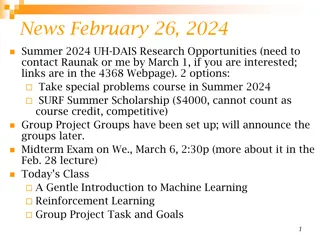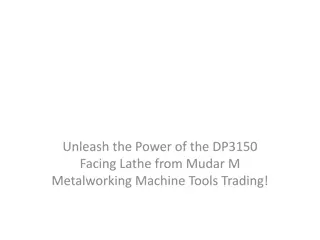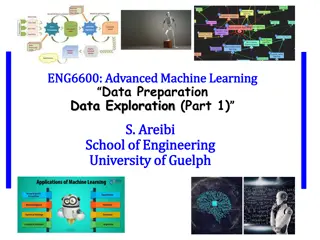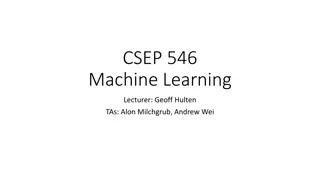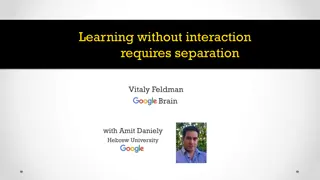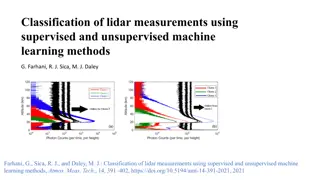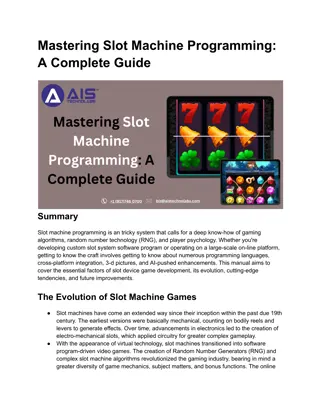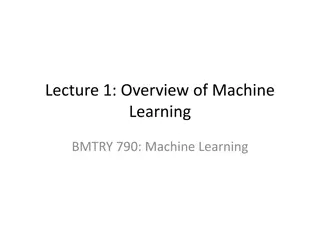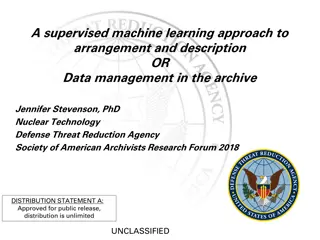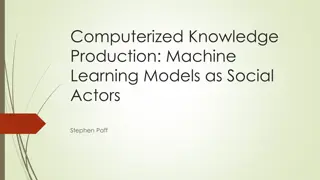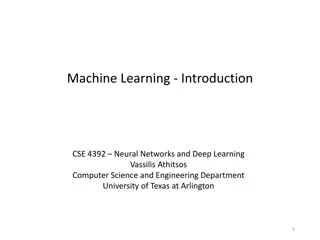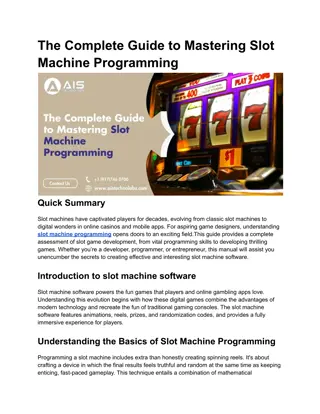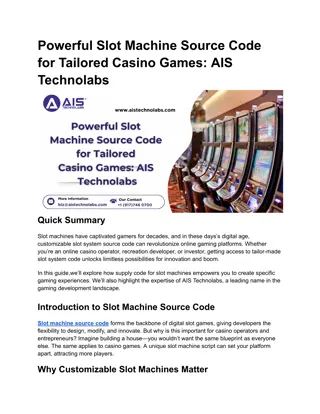Introduction to Machine Learning
Machine learning involves programming computers to optimize performance using example data or past experiences. It is used when human expertise is lacking, explanations are unclear, solutions change over time, or specific adaptations are needed. Learning general models from data is crucial in various fields such as retail, finance, medicine, and telecommunications. Data mining and knowledge discovery in databases help identify valuable patterns, with applications ranging from market analysis to medical diagnosis. Statistics and computer science play key roles in developing and evaluating machine learning algorithms, driving advancements in speech recognition, computer vision, and more.
Download Presentation

Please find below an Image/Link to download the presentation.
The content on the website is provided AS IS for your information and personal use only. It may not be sold, licensed, or shared on other websites without obtaining consent from the author.If you encounter any issues during the download, it is possible that the publisher has removed the file from their server.
You are allowed to download the files provided on this website for personal or commercial use, subject to the condition that they are used lawfully. All files are the property of their respective owners.
The content on the website is provided AS IS for your information and personal use only. It may not be sold, licensed, or shared on other websites without obtaining consent from the author.
E N D
Presentation Transcript
CHAPTER 1: Introduction
Why Learn? Machine learning is programming computers to optimize a performance criterion using example data or past experience. There is no need to learn to calculate payroll Learning is used when: Human expertise does not exist (navigating on Mars), Humans are unable to explain their expertise (speech recognition) Solution changes in time (routing on a computer network) Solution needs to be adapted to particular cases (user biometrics) 2
What We Talk About When We Talk About Learning Learning general models from a data of particular examples Data is cheap and abundant (data warehouses, data marts); knowledge is expensive and scarce. Example in retail: Customer transactions to consumer behavior: People who bought Da Vinci Code also bought The Five People You Meet in Heaven (www.amazon.com) Build a model that is a good and useful approximation to the data. 3
Data Mining/KDD Definition := KDD is the non-trivial process of identifying valid, novel, potentially useful, and ultimately understandable patterns in data (Fayyad) Applications: Retail: Market basket analysis, Customer relationship management (CRM) Finance: Credit scoring, fraud detection Manufacturing: Optimization, troubleshooting Medicine: Medical diagnosis Telecommunications: Quality of service optimization Bioinformatics: Motifs, alignment Web mining: Search engines ... 4
What is Machine Learning? Machine Learning Study of algorithms that improve their performance at some task with experience Optimize a performance criterion using example data or past experience. Role of Statistics: Inference from a sample Role of Computer science: Efficient algorithms to Solve the optimization problem Representing and evaluating the model for inference 5
Growth of Machine Learning Machine learning is preferred approach to Speech recognition, Natural language processing Computer vision Medical outcomes analysis Robot control Computational biology This trend is accelerating Improved machine learning algorithms Improved data capture, networking, faster computers Software too complex to write by hand New sensors / IO devices Demand for self-customization to user, environment It turns out to be difficult to extract knowledge from human experts failure of expert systems in the 1980 s. 6 Alpydin & Ch. Eick: ML Topic1
Applications Association Analysis Supervised Learning Classification Regression/Prediction Unsupervised Learning Reinforcement Learning 7
Learning Associations Basket analysis: P (Y | X ) probability that somebody who buys X also buys Y where X and Y are products/services. Example: P ( chips | beer ) = 0.7 Market-Basket transactions TID Items 1 Bread, Milk 2 Bread, Diaper, Beer, Eggs 3 Milk, Diaper, Beer, Coke 4 Bread, Milk, Diaper, Beer 5 Bread, Milk, Diaper, Coke
Classification Example: Credit scoring Differentiating between low-risk and high-risk customers from their income and savings Discriminant: IF income > 1 AND savings > 2 THEN low-risk ELSE high-risk Model 9
Classification: Applications Aka Pattern recognition Face recognition: Pose, lighting, occlusion (glasses, beard), make-up, hair style Character recognition: Different handwriting styles. Speech recognition: Temporal dependency. Use of a dictionary or the syntax of the language. Sensor fusion: Combine multiple modalities; eg, visual (lip image) and acoustic for speech Medical diagnosis: From symptoms to illnesses Web Advertizing: Predict if a user clicks on an ad on the Internet. 10
Face Recognition Training examples of a person Test images AT&T Laboratories, Cambridge UK http://www.uk.research.att.com/facedatabase.html 11
Prediction: Regression Example: Price of a used car x : car attributes y : price y = g (x | ) g ( ) model, parameters y = wx+w0 12
Regression Applications Navigating a car: Angle of the steering wheel (CMU NavLab) Kinematics of a robot arm 1= g1(x,y) 2= g2(x,y) 2 (x,y) 1 13
Supervised Learning: Uses Example: decision trees tools that create rules Prediction of future cases: Use the rule to predict the output for future inputs Knowledge extraction: The rule is easy to understand Compression: The rule is simpler than the data it explains Outlier detection: Exceptions that are not covered by the rule, e.g., fraud 14
Unsupervised Learning Learning what normally happens No output Clustering: Grouping similar instances Other applications: Summarization, Association Analysis Example applications Customer segmentation in CRM Image compression: Color quantization Bioinformatics: Learning motifs 15
Reinforcement Learning Topics: Policies: what actions should an agent take in a particular situation Utility estimation: how good is a state ( used by policy) No supervised output but delayed reward Credit assignment problem (what was responsible for the outcome) Applications: Game playing Robot in a maze Multiple agents, partial observability, ... 16
Resources: Datasets UCI Repository: http://www.ics.uci.edu/~mlearn/MLRepository.html UCI KDD Archive: http://kdd.ics.uci.edu/summary.data.application.html Statlib: http://lib.stat.cmu.edu/ Delve: http://www.cs.utoronto.ca/~delve/ 17
Resources: Journals Journal of Machine Learning Research www.jmlr.org Machine Learning IEEE Transactions on Neural Networks IEEE Transactions on Pattern Analysis and Machine Intelligence Annals of Statistics Journal of the American Statistical Association ... 18
Resources: Conferences International Conference on Machine Learning (ICML) European Conference on Machine Learning (ECML) Neural Information Processing Systems (NIPS) Computational Learning International Joint Conference on Artificial Intelligence (IJCAI) ACM SIGKDD Conference on Knowledge Discovery and Data Mining (KDD) IEEE Int. Conf. on Data Mining (ICDM) 19
Summary COSC 6342 Introductory course that covers a wide range of machine learning techniques from basic to state-of-the-art. More theoretical/statistics oriented, compared to other courses I teach might need continuous work not to get lost . You will learn about the methods you heard about: Na ve Bayes , belief networks, regression, nearest-neighbor (kNN), decision trees, support vector machines, learning ensembles, over-fitting, regularization, dimensionality reduction & PCA, error bounds, parameter estimation, mixture models, comparing models, density estimation, clustering centering on K-means, EM, and DBSCAN, active and reinforcement learning. Covers algorithms, theory and applications It s going to be fun and hard work 20 Alpydin & Ch. Eick: ML Topic1
Which Topics Deserve More Coverage if we had more time? Graphical Models/Belief Networks (just ran out of time) More on Adaptive Systems Learning Theory More on Clustering and Association Analysis covered by Data Mining Course More on Feature Selection, Feature Creation More on Prediction Possibly: More depth coverage of optimization techniques, neural networks, hidden Markov models, how to conduct a machine learning experiment, comparing machine learning algorithms, 21 Alpydin & Ch. Eick: ML Topic1


